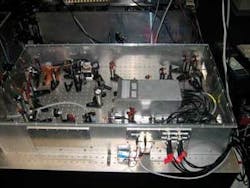ULTRAFAST SYSTEMS: High-repetition-rate OPAs get smaller and simpler

Optical-parametric-amplifier (OPA) systems in the ultrafast regime provide broad tunability for a range of applications, but typical designs present the familiar tradeoff of pulse energy for repetition rate. Commonly, high pulse energies provided by complex chirped-pulse amplified systems can pump OPAs but remain limited to kilohertz repetition rates.
More recently, megahertz systems have been demonstrated, but present a significant increase in complexity because they require the use of fibers to either recompress pulses or create the continuum for seeding the optical parametric process. A recently reported variation on the theme, however, has demonstrated the direct pumping of an OPA with a femtosecond oscillator, with not a fiber in sight. The system provides relatively high-energy pulses in the near-IR at a repetition rate of 1 MHz.1
The work is part of a European Union-funded collaboration that started as an effort toward micromachining of optical waveguides, but progress in pump sources and nonlinear crystals has opened up new avenues in the laser technology itself. “Our group has a long tradition in the field of OPAs, but only at kilohertz repetition rates,” says Giulio Cerullo of the Polytechnic University of Milan (Milan, Italy). Cerullo’s group joined forces with Uwe Morgner’s group at the University of Hannover (Hannover, Germany), which provided a novel diode-pumped Yb:KYW (ytterbium-doped potassium yttrium tungstate) oscillator to pump the OPA.
The oscillator uses a standard saturable absorber mirror and chirped mirrors to provide passive modelocking, but the real trick is a high-speed electro-optic cavity dumper, which yields pulses at 1 MHz with energies up to 1.2 µJ at 1030 nm.
The Milan group uses two periodically poled lithium niobate (PPLN) crystals in a two-stage amplification setup to split the output pulses of the oscillator. Ten percent of the pump energy is focused into the first crystal, resulting in an output energy of approximately 1 nJ. Tuning is accomplished by simply changing the position of the crystal, which has 14 poling periods ranging from 25.9 to 29.5 µm. Spectrally selecting the signal beam from this stage, the team seeds a single-pass amplification stage in another PPLN crystal, pumped by the remainder of the oscillator pulse energy.
The output is as high as 190 nJ, with pulse widths around 220 fs. The signal and idler wavelengths can be tuned from 1.3 to 1.6 µm and 3.1 to 4.6 µm, respectively, and the peak efficiency in the amplification stage is 30%, comparable to existing OPA approaches. These parameters are ideal for semiconductor studies in which pulse energies must be kept low to avoid damage, but the repetition rate helps boost the signal-to-noise ratio for experiments with relatively low excitation levels.
Cerullo says the enabling technology for the OPA was the pump source, which is unique in its combination of pulse energy and repetition rate. Uwe Morgner believes that the simplicity of the system combined with its excellent noise properties make it ideal for many applications. As such, it’s clearly an attractive commercial product, and in fact the oscillators will make it to market through High Q Laser (Hohenems, Austria), a longtime collaborator with Morgner’s group. The commercial versions of the oscillator will be known as femtoNova and picoNova.
Further improvements
Improvements are sure to come, both on the pump-laser side and in the OPA itself. Morgner’s team has already demonstrated improvements in its cavity-dumped oscillator by moving to a thin-disc gain medium, resulting in pulse energies in excess of 3 µJ.2 The next step for raising pulse energy lies in optimizing the electronics. “The laser performance is limited by the nonlinear effects in the modulator crystal,” notes Morgner. “A further increase in switching voltage while maintaining the repetition rate would directly result in shorter crystals and thus in higher pulse energies.”
As for the OPA, a significant limiting factor is PPLN’s susceptibility to photorefractive damage. The group intends to try novel periodically poled crystals such as stoichiometric lithium tantalate and potassium titanyl phosphate to boost the damage threshold, and thereby the pulse energies.
While Cerullo has no plans to push his OPA system forward to production, the sheer utility of tunable microjoule pulses at megahertz repetition rates makes it a possibility for the future. “This is in principle a very simple device that could be easily industrialized, especially using optimized crystals,” Cerullo says. For now, Cerullo plans to develop a dual OPA system pumped by the same oscillator and demonstrate its use in two-color pump/probe spectroscopy, focusing on III-V semiconductor quantum dots and quantum-confined semiconductors.
REFERENCES
1. Marangoni et. al., Opt. Lett. 32, 1489 (2007).
2. Opt. Lett., in press.
D. Jason Palmer | Freelance writer
D. Jason Palmer is a freelance writer based in Florence, Italy.